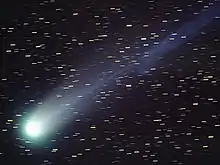| Discovery | |
|---|---|
| Discovered by | Yoshio Kushida and Osamu Muramatsu |
| Discovery date | 10 December 1993 |
| Designations | |
| 1993 X1, 2000 T2 | |
| Orbital characteristics | |
| Aphelion | 4.856927 |
| Perihelion | 2.756415 |
| Semi-major axis | 3.806671 |
| Eccentricity | 0.275899 |
| Orbital period | 7.43 |
| Inclination | 2.3673° |
| Last perihelion | February 27, 2016[1] September 22, 2008 |
| Next perihelion | 2023-Dec-06[2] |
| Physical characteristics | |
| Dimensions | 0.42 km[3] |
147P/Kushida–Muramatsu is a quasi-Hilda comet[4] discovered in 1993 by Japanese astronomers Yoshio Kushida and Osamu Muramatsu.
According to calculations made by Katsuhiko Ohtsuka of the Tokyo Meteor Network and David Asher of Armagh Observatory, Kushida–Muramatsu was temporarily captured by Jupiter as an irregular moon between May 14, 1949, and July 15, 1962, (12.17+0.29
−0.27 years).[4][5] It is the fifth such object known to have been captured.[4][6]
It is thought that quasi-Hilda comets may be escaped Hilda asteroids.[4] Comet Shoemaker–Levy 9, which collided with Jupiter in 1994, is a more famous example of a quasi-Hilda comet.[4]
References
- ↑ "147P/Kushida-Muramatsu Orbit". Minor Planet Center. Retrieved 2014-06-18.
- ↑ "Horizons Batch for 147P/Kushida-Muramatsu (90001071) on 2023-Dec-06" (Perihelion occurs when rdot flips from negative to positive). JPL Horizons. Retrieved 2023-04-29. (JPL#K083/2 Soln.date: 2009-Mar-12)
- ↑ "JPL Small-Body Database Browser: 147P/Kushida-Muramatsu" (last observation: 2009-02-22). Jet Propulsion Laboratory. Retrieved 2019-06-01.
- 1 2 3 4 5 Ohtsuka, Katsuhito; Yoshikawa, M.; Asher, D. J.; Arakida, H.; Arakida, H. (October 2008). "Quasi-Hilda comet 147P/Kushida-Muramatsu. Another long temporary satellite capture by Jupiter". Astronomy and Astrophysics. 489 (3): 1355–1362. arXiv:0808.2277. Bibcode:2008A&A...489.1355O. doi:10.1051/0004-6361:200810321. S2CID 14201751.
- ↑ MacGregor Campbell (14 September 2009). "Jupiter had brief encounter with icy companion". New Scientist. Retrieved 14 September 2009.
- ↑ Kerensa McElroy (14 September 2009). "Captured comet becomes moon of Jupiter". Cosmos Online. Archived from the original on 18 September 2009. Retrieved 14 September 2009.
External links
- Orbital simulation from JPL (Java) / Horizons Ephemeris
- 147P/Kushida-Muramatsu – Seiichi Yoshida @ aerith.net
- 147P/Kushida-Muramatsu
This article is issued from Wikipedia. The text is licensed under Creative Commons - Attribution - Sharealike. Additional terms may apply for the media files.

.png.webp)